#nauplius
Text
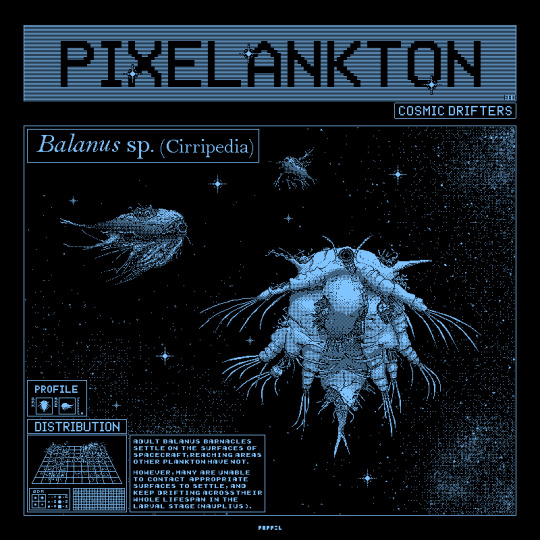
Adult Balanus barnacles settle on surfaces of spacecraft, reaching areas other plankton have not. However many are unable to contact appropriate surfaces to settle, and keep drifting across their whole lifespan in the larval stage (Nauplius).
#pixelankton#space#cosmos#nauplius#barnacle#poppel#cassettefuturism87#pixelart#1bit#scifi#biopunk#science#biology#plankton#zooplankton
282 notes
·
View notes
Text


Cyclops and its nauplius (x50)
A common specie of freshwater copepod, microscopic crustaceans which compose an important part of fresh-water zooplankton.
Their name is due to the fact that they have only one eye (a red point in front of their body, between their two front legs). They eat paramecies and are eaten in large quantities by baby fishes (as other zooplaktons, they reproduce very quickly so the population is stable). The nauplius (picture on the right) is the larva stade of the cyclops.
#zooplankton#cyclops#copepod#nauplius#microscope#biology#microbiology#microscopic life#nature#microorganisms#little animals#freshwater zooplankton#ecology#crustacean#microscopic crustacean#microbiome#ecosystem#one eye#larva
87 notes
·
View notes
Text

日本語
ノープベント
寒暖差と水圧の高い深海に住んでいる。海底で食べ物を探し、見つけるとすぐに周りの石と砂を体に吸い込む。この物質をミネラルに分解し、そのミネラルで殻を作って固め、煙としてクズを放出する。
ノープヂムニー
微生物とクズを食べて、成長に力を全部集中する。海底をかき回すのに触手を使って、泳ぎ回って色々なものを吸い込む。危険の気配を感じたら、ヘルメットまで自身を砂に埋めて煙を放出する。
フジツァン
成長する時、殻を海底に固定し、地面を喰い破っていく。それで殻がもっと大きくなる。このプロセスでは、大量の熱と煙を発生することで、深海の生物を誘う。煙を出す口に近づきすぎる生物は吸い込まれて食べられる。
English
Naupoot
It lives in the extreme temperatures and pressures of the deep ocean. It scours the ocean floor for food, and when it finds it, it sucks it into its body along with surrounding sand and rocks. It breaks down this material into minerals which it constructs its shell from, and ejects the waste as smoke.
Cysmoke
It eats microscopic life and scraps, and devotes all of its attention to growing larger. It uses its tentacles to stir up the ocean floor and then swims around, sucking everything out of the water. When it senses danger, it buries itself in the sand up to its helmet and ejects bursts of smoke.
Volcanicle
On reaching adulthood, it fixes its shell to a place on the ocean floor and eats through the ground, converting it into more shell. This process creates a massive amount of heat and smoke, which attract other deep sea life to its location. Creatures that get too close to the smoke vent are sucked in and eaten.
Name origin
ノープ comes from nauplius, the larval stage of barnacles. フジツァン is a combination of フジツボ (barnacle) and 富士山 (Mt Fuji, an active volcano). These are all based on the lifecycle of a barnacle and deep sea hydrothermal vents.
159 notes
·
View notes
Text
Y'all voted for a crustacean for Wet Beast Wednesday so I picked possibly the weirdest one to go over. We're talking about barnacles. Barnacles were initially classified as mollusks for understandable reasons as they look a lot like limpets. It wasn't until observation of the larvae that they were reclassified as very strange crustaceans. The hard outer shell contains a little crabby critter that will spend its entire life within. Barnacles can be loosely divided into acorn barnacles, who have their shells directly attached to a solid surface, and goose barnacles, who use a thick, muscular stalk they use to attach.
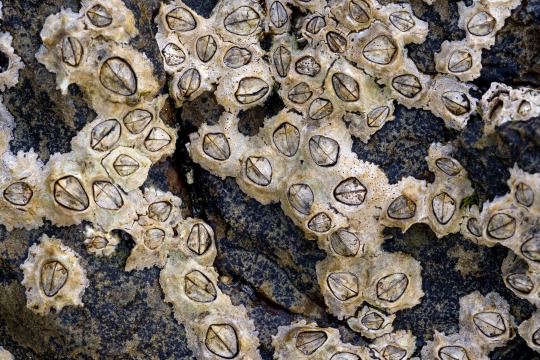
(image: acorn barnacles)
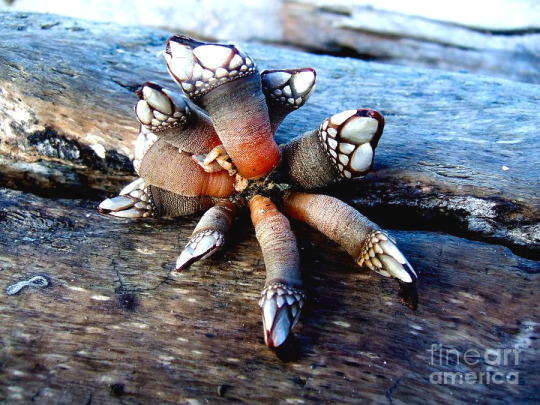
(image: goose barnacles)
Barnacle shells are derived from the same structures as the carapace of other crustaceans, leaving the barnacle within as a fleshy blob. Most species have an operculum that can open to allow feeding or close to retain water and avoid predators. The vast majority of barnacles are suspension feeders who will stick their legs out of the shell. These legs are covered in sticky filaments that snag plankton and organic material that will be pulled down to the mouth. A few goose barnacles lack cirri and require water movement to bring food into their shells. Barnacles that live in intertidal zones (roughly 25% of species) will close their shells during low tide to retain water. Because barnacles are so sedentary, they lack hearts and gills.
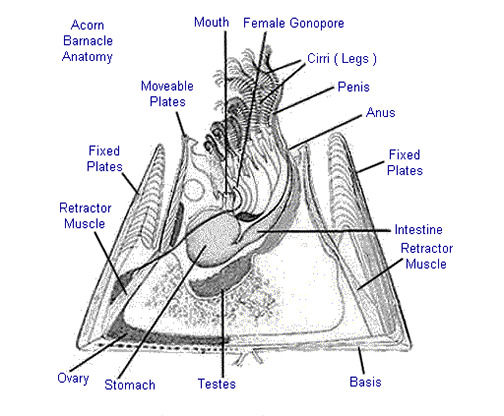
(image: a diagram of barnacle anatomy)
Most barnacles are simultaneous hermaphrodites, producing male and female gametes at the same time (as opposed to sequential hermaphrodites, who change sex during their lives), those some species are gonochoric (distinct males and females) or androdioecious (distinct males and hermaphrodites). Because they are sessile, mating is difficult for barnacles and they have developed internal and external reproduction depending on species. Those that reproduce internally have enormously long, flexible penises that are used to reach and fertilize their neighbors. The barnacle famously has the longest penis to body size ration of any animal, with the penis growing up to 8 times longer than the rest of the animal. Other species use a technique called spermcasting in which male gametes are released into the water and picked up by females/hermaphrodites for fertilization. Juvenile barnacles go through two distinct larval stages. The first of these is the nauplius, a one-eyed, free-swimming larva that will go through 6 molts before transforming into the next stage. The next stage is the cyprid and its only purpose it to find a suitable pace to spend the rest of its life. It will use its antennae to examine hard surfaces with a number of criteria including surface texture, chemistry, color, biofilm, and the presence of other barnacles. Cyprids have limited energy stores as they cannot feed and test have shown they get less picky the longer they spend in this stage. Once a cyprid finds a suitable spot it will permanently attach itself headfirst using a secreted glue and metamorphose into a juvenile barnacle.

(image: a diagram of barnacle life stages)
Some species of barnacle aren't content living on rocks and instead attach to animals. Various barnacle species have adapted to latch onto other animals, including whales, sea turtles, mollusks, crustaceans, and other arthropods. In most cases, these barnacles have a commensal relationship with their hosts; the barnacle gets the benefit of a free ride and protection from predators while the host neither benefits or suffers from the relationship. In cases of heavy infestation, the barnacles could cause irritation or drag and could cause problems for their hosts. One group of barnacles, the rhizocephalans, have gone further and adapted a fully parasitic lifestyle. These have become so heavily adapted they are virtually unrecognizable as barnacles or even arthropods, lacking shells, appendages, body segments, and most organs. A female consists of gonads, a few muscles, the remnants of a nervous system, and a cuticle. Males have even less, they are reduced to a cluster of cells that live inside the females to provide a constant supply of sperm. Parasitic barnacles mostly target decapods (crabs, lobsters, shrimp, etc) thous some species target other crustaceans, including other barnacles. When a female larva attaches to a host, it grows a root-like cell mass called the vermigon into the host's body that absorbs nutrients through the host's blood. The most famous group of parasitic barnacles are in the genus Sacculina, who parasitize crabs. When these barnacles attach to a crab, they sterilize it and prevent it from molting or regrowing lost limbs. It also grows a sac where the female crab would hold its egg sac and forces the crab to protect it as if it really were an egg sac. When Sacculina infests a male crab, it interferes with hormones, causing the male crab to take on a feminine body plan and act female. When the barnacle is ready to release its larvae, the crab will assist as though it was releasing its own egg case.
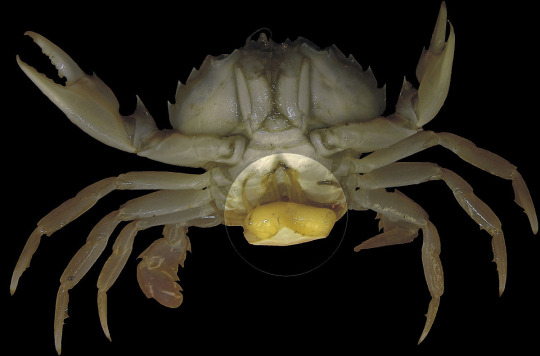
(Image: Sacculina force-femming a crab)
Goose barnacles are the subject of a famous myth involving geese that granted them their name. The barnacle goose is a species native to Europe but in the days when spontaneous generation was accepted, nobody knew how they reproduced. The geese migrate to the arctic to mate and lay eggs, but nobody knew that at the time. A common myth arose where goose barnacles attached to driftwood were said to be the remnants of goose trees, where the barnacle would grow and eventually release a fully-grown goose. This myth is where the name barnacle came from. The crustaceans were named after the goose.

(image: a drawing of a goose tree)
#wet beast wednesday#barnacles#crustacean nation#crustaceans#parasite#biology#zoology#marine biology#marine life#that one parasite that force-femmes crabs
191 notes
·
View notes
Text

ok i saw 3 dendrogaster related posts on my dashboard i had to make a fakemon based on them
nauplien is based on the nauplius stage of a dendrogaster
gasteroid is based on the adult stage of a dendrogaster
theyre both based on alien life found inside meteors because starfish belong to the class asteroidea
35 notes
·
View notes
Text
Rough doodle of the 3 main characters for the gladiator WIP... the husband and wife, working names are Nauplius and Modesta respectively, and the gladiator they hire to take part on their murder scheme, who im calling 'The Minotaur.'


15 notes
·
View notes
Note
Iirc you once mentioned that the front limbs of amblypigi are used as feelers, do you know of any arthropods where the opposite has happened, their antennae have been adapted into limbs?
many aquatic crustaceans have a larval stage called the nauplius, where their antennae are used as swimming limbs. I can’t think of any others, actually…
34 notes
·
View notes
Note
hi! im so curious abt whether or not you have any hcs/thoughts abt when helen and penelope found out abt what happened to agamemnon and then later clytemnestra? (srry if youve answered smth similar before! i looked thru the tags and didnt seem to find anything)
With Penelope, I kind of have it planned where I go into a bit with how Nauplius, the father of Palamedes, goes and fucks with the other kings by going to their homelands and telling their wives they're bringing back a new bride so that the queens would, you know, take on a lover or boot out the king when he comes back.
I think it's funny af that Palamedes' dad went around trying to fuck with the other king's kingdoms and it worked as most of their wives had affairs but then you have Penelope, the WIFE of the guy who set your son up to get murdered, and she wasn't buying it. Got revenge on all the kings except for the one who was truly responsible because his wife was too cool.
I love imagining him trying to convince Penelope, who's already like "You're telling me, my husband, the embodiment of simping, is going to replace me? When he knows I'm the best thing that ever happened to him?"
But when she realizes who this man is??? She's fucking FURIOUS. this is the father of the man who put their CHILD in such a dangerous situation and is the reason why her husband is away from her. She throws him out but Nauplius gets to Odysseus' parents and...tells them he died. He lied so at least he could hurt Odysseus in some way at least...Also Ironic as Palamedes I'm pretty sure is a distant descendant of Poseidon. There's something there >:D
But idk for sure how EXACTLY I'm going to have it go down but I like the thought of the family at least COMMUNICATING and sometimes visiting each other. Maybe Penelope visiting Hermione as her auntie kind of. Maybe visiting her siblings, mother, and father (until he tries to convince her to remarry again. then she avoids him :( ). Same with Clytemnestra. And idk for SURE but everyone has an inkling that she's having an affair with Aegisthus but no one knows for sure. Penelope tries to bring up Nauplius but...isn't able to get anywhere (can't spoil everything!)
When she finds out what happens it's a "I KNEW IT!" and anger as she's saddened as she cared for both these people so much as she grew up with them nearby. First Helen was kidnapped, her husband is gone, she can't see her siblings as often, now another person she grew up with and cared about is not only dead but also the one who killed them was another person she cared about! And she doesn't know how Ithaca, being a smaller island as a whole, could help their children. She's sad for them but also knows that she already has so much on her plate that she can't really help them. (also somewhat selfish :P Her and Odysseus are like-minded)
There's a part of me that thinks that, being the somewhat "I will do whatever I have to do to get on top" part of her would just "play along" to get resources from Mycenae while deep down feeling like "There will be consequences" or she would completely ignore and no longer do things with them until Orestes takes it back. She's got a lot going on with the suitors as well so idk for sure yet ¯\_(ツ)_/¯
WITH HELEN, that's much more complicated. She's been gone so long, and has to worry about getting back to her kingdom and looking forward to seeing her family again only to realize that some of her family has done something horrendous. Her sister killed her Brother-in-law! Menelaus' brother!! She grew up caring for Agamemnon as well! And also her husband is grieving!!! There is...SO MUCH going on. She's probably able to grieve a bit while in Egypt (because if I remember correctly they find out through Proteus, yeah?) There's grief for the sister she knew. She was ripped away from Hermione, how could her own sister not only kill her husband, but also send her children away and be so horrible to them?! But kind of in the same way as Penelope, so much on their plate with just returning, that they don't know how much they can do until later. I don't think they would be willing to do any sort of interaction with Mycenae afterward though. :P
Little side thing, but since I love MenOdy's BROTP, I'd like to think that Menelaus, being told by Proteus, a deity, where Odysseus was at, was kind of "mind-wiped" until Telemachus comes as "it's not the right time yet" with the gods. Menelaus and Helen realize afterward of "HoLY FUCK WE SHOULD'VE TOLD PENELOPE!!!" as they care about both Odysseus and Penelope. Also doesn't help that yeah, gotten news about bro/brother in law being murdered so there's a LOT going on. but I don't like to think they simply forgot??? when for one thing, I plan to write them as all very close?? NO >:(
It was just prophecy shit of "Hey, it HAS to be 20 years, mm'kay?"
#House of Atreus shit is always buzzing in the back of my mind but not as loud as the Odyssey👀#ask#my headcanons#shot by odysseus#Mad rambles#anon#THANK YOU!!! :D#I am a bit all over the place and I'll probably need to reread Proteus bit again :P#I always just focus on “haha. Menelaus is a seal!!! He's a little sealy seal!” and so...yeah...ADHD makes you focus on the IMPORTANT stuff
8 notes
·
View notes
Text
the first stage of crustacean larvae come in two forms, "nauplius" which have a single eye and three pairs of simple swimming appendages, and "zoea" which are much more developed
a nauplius and the copepod it develops into:


the zoeae can be very cute! look at this lobster zoea

the triops retains this eye!
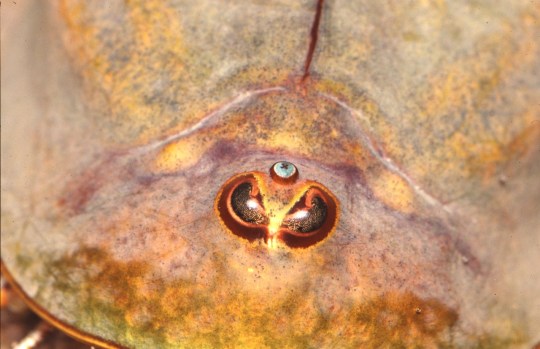
9 notes
·
View notes
Text
There are many tragic tales related to the Trojan war. Nauplius, a nasty, vengeful sailor caused several of them by making quite a few soldiers very, very miserable as an act of revenge.
15 notes
·
View notes
Note
ok. what is in your opinion the funniest greek myth you know 🥞
hi this ask made me realize i don't actually know that many individual myth stories (i would like to change that!) and also all of them i could think of (or find) are Sad As Hell! they might be a little funny but only in sort of dark humor ways. you know? maybe Phaethon, the son of the sun god Helios who begged to take his dad's sun chariot out for a ride, perhaps to impress his friends, and was so shitty at driving it (fun fact, this is their myth for why Africans had darker skin than them. bc of getting scorched by the untamed sun. well they got the sun part right at least, 4/10 job everybody) that things got chaotic and Zeus shot him down, and he fell into the Eridanus river and drowned ? and then his sisters were so sad they turned into trees ? it might be funny bc it reflects modern stories of driving your parents' car and fucking it up so bad
anyway i think i have my answer in the form of a very brief anecdote. when i was looking around i found this, said by the traveler Pausanias in his records of traveling Greece:
[2.38.2] Fifty stades, I conjecture, from Temenium is Nauplia, which at the present day is uninhabited; its founder was Nauplius, reputed to be a son of Poseidon and Amymone. Of the walls, too, ruins still remain and in Nauplia are a sanctuary of Poseidon, harbors, and a spring called Canathus. Here, say the Argives, Hera bathes every year and recovers her maidenhood.
he says that there is a spring where Hera bathes herself yearly to restore her virginity which is just an incredibly funny concept to me. shes married. she has kids, in and maybe out of wedlock. would this work if a mortal did it? free virginity in Nauplia?

7 notes
·
View notes
Photo

Planktoon - the nauplius pokemon
Type: water
Ability: Planktonic (Boosts evasion in Rain) or Swift Swim
They drift aimlessly along with ocean currents. A large enough group can overpower any threat, but they lack the leadership skills to organise on their own.
Defencyprid - the probe pokemon
Type: water
Ability: Planktonic or Swift Swim
They lead Planktoon on reconaissance missions to find the perfect rock on which to evolve. They sometimes attach to Wailord by mistake and must be pried off.
Battlestacean - the tank pokemon
Type: water/rock
Ability: Battle Armour or Rain Dish
Moves: Iron Defense, Hone Claws, Hydro Pump, Meteor Beam, Fire Blast, Thunder, Blizzard, Hyper Beam, Focus Blast, Steel Beam
Battlestacean evolves from Defencyprid by Hard Stone.
Its rocky shell is nigh impenetrable, making head-on attacks ill-advsed. From its position of relative safety it fires gratuitous ordnance from its claws to dispatch its enemies.
Remakes of extremely old fakes, which I will not be linking to because they suck.
Want me to draw your fakemon idea? I’m taking commissions! https://ko-fi.com/seizurecube
50 notes
·
View notes
Note
The Life Cycle of Shrimp
Shrimp Eggs: Oh, the miraculous beginning of life! These tiny, almost indiscernible eggs hold the future of these magnificent creatures. They serve as delectable morsels for zooplankton, fueling their growth until they are ready to unleash their potential as larvae.
Nauplius Larva and Protozoea Larva: In this stage of their existence, the larvae are bursting with energy. They may not yet possess control over their own destiny, but they still engage, interact, and influence the world around them. Acting as both consumers and sustenance for other species within the vast water column, their significance cannot be understated.
Mysis Larva: The allure of light beckons to these enchanting creatures. With every graceful movement, they outsmart predators by swimming away from the water's depths. Yet, their hunger remains insatiable, as they continue to feast on the abundance of zooplankton and phytoplankton.
Postlarva: Ah, the metamorphosis is underway! These resilient beings venture toward brackish waters and embark on a journey of self-discovery. As they take on the appearance and habits of their majestic ancestors, they dedicate themselves to scouring the seabed for sustenance. They play an integral role in the intricate tapestry of the food web, both as scavengers of decaying animal remnants and as prey for hungry fish.
Juveniles: A vibrant tapestry of interactions unfolds as these young warriors venture further into the estuaries. They embrace their destined roles as both predator and prey, leaving an indelible impact on their surroundings. With each voracious bite and insatiable hunger, they shape their environment and prepare for the ultimate journey to the open sea.
Subadult: The ebb and flow of temperature governs the growth and migration of these brave souls. With determination, they navigate the water's depths, feasting upon the bountiful delights that lie beneath. Yet, their time is marked by uncertainty, as many will soon face the harvesters' nets, their lives cut short before they can reach their full potential.
Adult: Majestic giants of the sea, basking in their authoritative presence upon the ocean floor. However, their reign is not without challenges. Pinfish, silver sea trout, sharks, and redfish all desire a taste of their succulent flesh. Yet, there are a select few who evade these voracious predators, surviving to propagate the species. As the temperature of the water column rises, the females are ignited with an unyielding desire to spawn, releasing countless eggs into the world, thus commencing the wondrous cycle once more.
— the goblin
thank you i lovr you forever
3 notes
·
View notes
Text

Nauplius
4 notes
·
View notes
Note
if medusa is your mother who is your farher?

Ulysses was briefly silent. He can recall the eventful day when his mother blurted out the truth when an insipid demigod tried to attack her. All his life Medusa taught him to be defensive, untrusting and thriving in solitude. But how to handle anger and fear- knowing that he carried the blood of one of the most powerful of the Olympians, is something he did not know yet. He had the same tempestuous rage, the similarities in power, except he did not have the birthright throne that Amphitrite’s son, Triton had. Life has been nothing but competition and experiences caused him to change.
Now he was quick to admit the truth, out of sheer spite.

“It’s Poseidon, the god of the sea, earthquakes and horses. He is my father, and he fathered many more. Theseus, Triton, Polyphemus, Orion, Belus, Agenor, Neleus, Atlas, Rhode, Benthesikyme, Arion, Chrysaor, Pegasus and Nauplius. I keep track of my siblings.”
5 notes
·
View notes
Text
Shrimp Reproduction
-- sex determination is fixed and shrimp are protandrous hermaphrodites
-- external fertilization
-- paired mating
-- up to 3,000 eggs per female
-- stages
1. nauplius
2. protozoea
3. mysis
4. post-mysis
5. juvenile
6. adult
-- habitats
-> marine surface waters in plankton
-> estuary
-> bay
-> open ocean
-> seabed
.
Patreon
#studyblr#notes#science#marine science#marine science notes#marine sci#marine sci notes#oceanography#oceanography notes#science notes#scienceblr#sciblr#shrimp life cycle#shrimp biology#biology#bio#marine biology#marine biology notes#marine bio#marine bio notes#biology notes#bio notes
1 note
·
View note